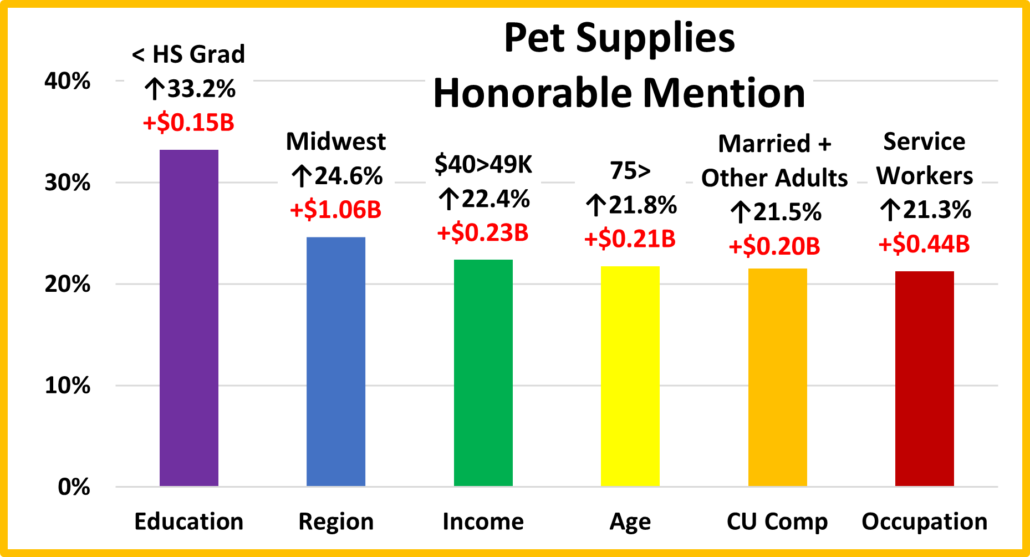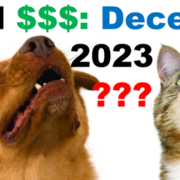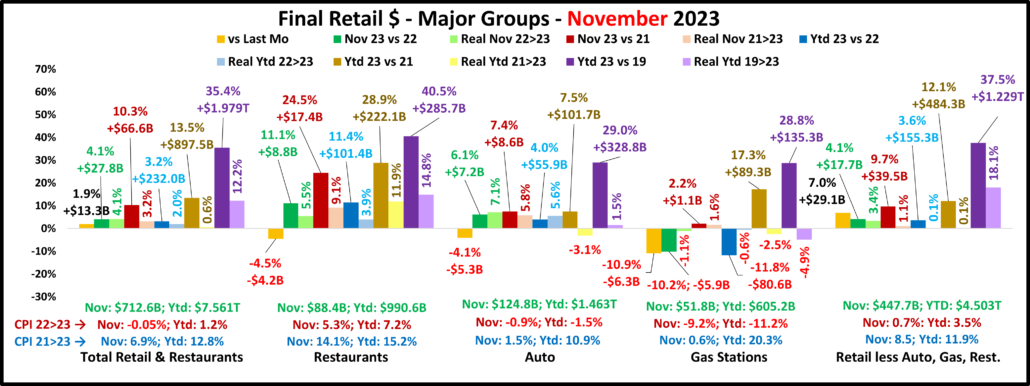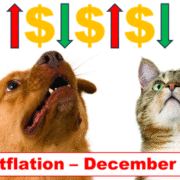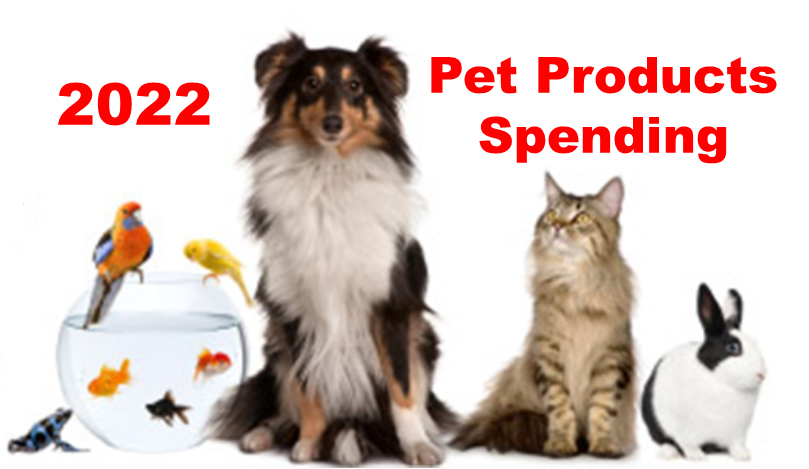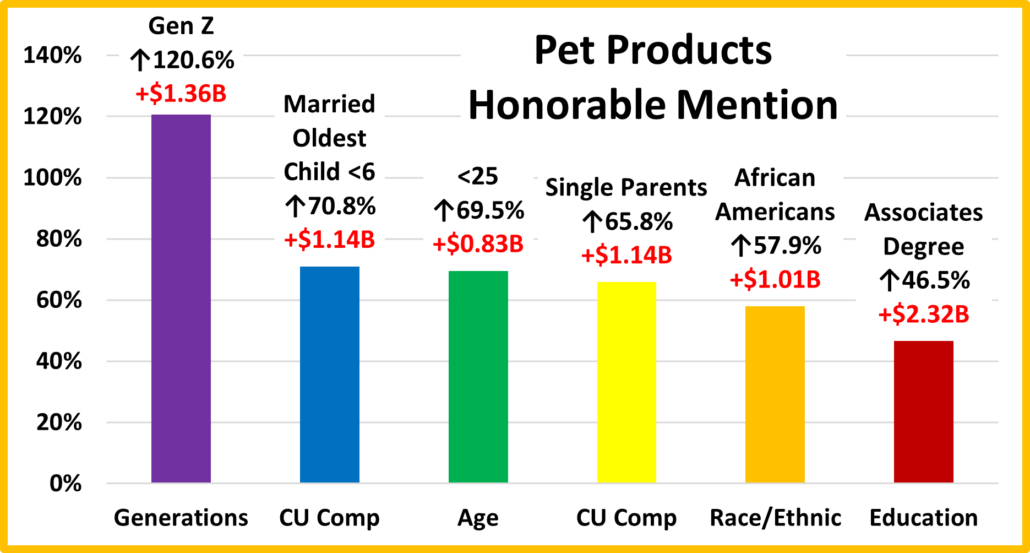2022 Pet Supplies Spending was $21.94B – Where did it come from…?
Next, we’ll turn our attention to Pets and Supplies. We’ll see definite differences from Pet Food as the spending in the Supplies segment is more discretionary. There are other factors too. Spending can be affected by the spending behavior in other segments as consumers often trade $ between segments. However, the biggest factor is price. Many categories have become commoditized so pricing changes can strongly impact Consumers’ buying behavior. In the 2nd half of 2016, deflation began, and Supplies started a 24 month spending lift, totaling $5B. Prices turned up in mid-2018 due to new tariffs and Supplies $ fell a record -$3B in 2019. In the 2020 pandemic, Supplies weren’t a necessity, so sales continued to drop, -$1.7B. In 2021, Pet Parents caught up with their children’s needs and Supplies spending exploded, +$8.65B. In 2022, the “binge buy” was not repeated and inflation was high. Spending fell -$1.86B, -7.8% to $21.94B.
Let’s see which groups were most responsible for the bulk of Pet Supplies spending in 2022 and the $1.86B decrease. The first chart details the biggest pet supplies spenders for each of 10 demographic categories. It shows their share of CU’s, share of Supplies spending and their spending performance (Share of spending/share of CU’s). All groups are the same as Total Pet and are presented in the order that reflects their share of Total Pet Spending. This highlights the differences in importance. The biggest difference is in performance. There are 7 groups with performance of 120% or more, the most of any segment. That’s 2 more than Total Pet and 3 more than Pet Food. It’s also 1 more than 2021 which indicates that Supplies spending became less balanced in terms of the big groups in 2022.
- Race/Ethnic – White, not Hispanic (81.5%) down from 83.2%. This large group accounts for the vast majority of spending in every segment. Their share decreased and their performance fell from 123.9% to 121.2% but they moved up from #6 to #4 in importance in Supplies Spending. Minority groups account for 32.8% of all CUs but spend only 18.5% of Supplies $. This is actually their biggest share of any segment. Only African Americans spent more.
- Housing – Homeowners (78.8%) up from 76.9%. Homeownership is a big factor in pet ownership and spending in all segments. Their performance grew to 121.0%, from 118.9% and they joined the 120% club at #5 in importance in Supplies spending, up from #8 in 2021. Only Homeowners w/o a Mortgage spent more on Supplies in 2022.
- # in CU – 2+ people (83.3%) the same as 2021 but their performance increased to 120.8%, from 119.8%. Only 3 People CUs spent more, +$0.44B and $4+ People CUs were down -$1.93B. Performance was aided by a drop in CUs.
- Area – Suburban & Rural (70.3%) down from 76.0%. A big drop in share and their performance fell to 107.3%, from 117.8% in 2021. They’re now last in importance. The big Suburbs, over 2500 population were the only segment to spend less, but the decrease was substantial, -$2.74B. The Areas <2500 Population spent a little more, +$0.08B (+1.5%) but Center City had double digit percentage growth, +$0.80B (+14.0%).
- Education – Associate’s Degree> (72.0%) down from 76.1%. This expanded group lost market share in 2022 and their performance level also decreased from 131.9% to 124.8%. Higher Education fell from 2nd to 3rd in importance. The drop was driven by College Grads, especially those with Advanced Degrees, who spent -$2.99B less. There was a clear spending divide. College Grads spent less while all groups with less than a BA/BS spent more. Those with an Associate’s Degree had the biggest lift, +$1.18 (+63.6%).
- Income Over $70K (71.0%) up from (68.4%) A gain in share but their performance fell from 152.7% to 150.2%. Income remains the most important factor in increased Pet Supplies Spending. Both <$70K and $70K> spent less. However, all segments from $70K to $199K spent more while $200K> spent -$2.68B less. The <$70K group had a different pattern. The $40>49K group spent $0.23B more but all other groups spent less. Of Note: All incomes over $70K perform above 100% with an average of 150.2%. Those <$70K have a performance average of 55.0%.
- # Earners – “Everyone Works” (69.7%) down from 73.4%. Their performance fell from 129.5% to 119.5% and they dropped from #4 to #7 in importance. In this group, all adults in the CU work. The # Earners is more important than in Food but it is income that truly matters. The results were mixed. No Earner, Singles, 1 Earner, 2+ CUs & 3+ Earners spent more. All other segments spent less, especially 2 Earners. Only CUs with 2+ earners perform above 100%.
- Occupation – All Wage & Salary Earners (68.7%) up from 60.9%. Their performance was 114.0%, up from 102.6%. Tech/Sls/Cler had the only decrease in the group. Mgrs/Prof were +$0.58B. The gain in share and performance was largely due to a small spending lift by the group, while All Other/Unemployed & Self-Employed spent a lot less.
- CU Composition – Married Couples (60.7%) down from 62.0%. Their performance also decreased from 130.8% to 127.1% but they moved up from 3rd to 2nd in importance. Married, Oldest Child 18> had the biggest lift, +$1.17B but Married, Couples Only & those with additional Adults also spent more. Married, Oldest Child 6>17 had the biggest drop , down -$2.77B but all other CU types with or without kids spent less..
- Age – 35>64 (61.8%) down from 66.3%. Their performance level decreased to 118.6% from 126.6%. They fell from #5 to #8 in importance and dropped out of the 120% club. Only the 25>44 yr-old groups spent less. All others spent more. A -$2.81B decrease in spending by 35>44 yr-olds caused the big drop in share and performance. The biggest lift was only +$0.42B by 45>54 yr-olds. Supplies spending skewed a little older in 2022.
Pet Supplies spending still skews more towards younger and higher income CUs than Food. However, the biggest difference may be in the spending disparity in segments within the big groups. Supplies now has 7 big groups with perfomance of at least 120%. That’s up from 6 in 2021 and 5 in 2020. It’s also almost twice as many as the 4 in Pet Food.
Now, we’ll look at 2022’s best and worst performing Pet Supplies spending segments in each category.
Almost all of the best and worst performers are those that we would expect. There are truly no big surprises. In Pet Supplies spending, there are only 5 that are different from 2021, up from 4 last year. That is 2 more than Veterinary & Services but 2 less than Total Pet and 6 less than Pet Food. They are also tied with Total Pet & Food for the most new winners – 4. In 2021, Supplies had the fewest changes and new winners. In terms of disparity, the difference between the avg winner & loser was 87.5%, down radically from 123.6% in 21. Changes from 2021 are “boxed”. We should note:
- Income matters in Supplies spending.
- Like Pet Food, the $150>199K> group was the top performer. They replaced $200K> which is the top performer in both Service Segments and Total Pet. BTW: It is #2 in Food & Supplies so $150K> is #1 for all.
- # Earners – 3+ Earners replaced 2 Earners at the top but again, only these 2 groups performed above 100%.
- Age – 45>54 traded places with 35>44 for the win. However, 35>44, 116.7% barely edged out 55>64, 116.1% for 2nd place. The 35>54 groups are mostly Gen Xers. Gen X “rules” in Supplies spending.
- Region – The West won again but the Midwest also performed over 100%. The Northeast replaced the South at the bottom. However, the performance disparity from 1st to last fell from 103% in 2021 to 41% in 2022.
- CU Composition – Married, Oldest Child 18> replaced Oldest Child 6>17 at the top while Singles held their spot at the bottom. In 2022, all Married CUs – with or without children, performed over 100%.
It’s time to “Show you the money”. Here are segments with the biggest $ changes in Pet Supplies Spending.
In 2019, Tarifflation caused a record $2.98B drop in Supplies spending. 2020 brought the pandemic and pet parents focused on “needs” so the more discretionary Supplies segment fell another $1.65B. In 2021 Pet Parents caught up on the Supplies needed by their “children” and spent a record $8.65B more. In 2022, the binge wasn’t repeated so the $ fell -$1.86B. In the chart, there is only 1 repeat from 2021, but 5 segments switched from last to 1st and 10 flipped from 1st to last. This is a lot of turmoil. In 2021, 97% of all segments spent more and in 9 categories all segments had increases. In 2022, despite the decrease, 52% of segments still spent more but no category was all positive. Here are the specifics:
- Income – $150>199K took the top spot as $200K> flipped from 1st to last.
- Winner – $150>199K – Pet Supplies Spending: $3.64B; Up +$1.30B (+55.3%) 2021: $200K>
- Loser – $200K> – Pet Supplies Spending: $3.73B; Down -$2.68B (-41.9%) 2021: $40>49K
- Comment – In the <$70K group, only the 2021 loser, $40>49K spent more. In the $70K> group, only the 2021 winner, $200K> spent less, but it was substantial , -$2.68B. Overall, in both the under/over $70K and the under/over $100K groups both higher & lower spent less but the lower incomes had the biggest drop.
- Education – Associate’s Degree won while Advanced College Degrees flipped to the bottom.
- Winner – Associate’s Degree – Supp. Spending: $3.03B; Up +$1.18B (+63.6%) 2021: Adv College Degree
- Loser – Adv. College Degree – Supplies Spending: $5.84B; Down $2.99B (-33.9%) 2021: <HS Grad
- Comment – The spending pattern was the opposite of what we expected. All College Grads spent less while all groups without a BA/BS spent more. The lift did increase with education, but peaked at an Associate’s degree.
- CU Composition – Married, Oldest Child 18> finished on top while Married, Oldest Child 6>17 flipped from 1st to last.
- Winner – Married, Oldest Child 18> – Supplies: $2.92B; Up $1.17B (+66.9%) 2021: Married, Oldest Child 6>17
- Loser – Married, Oldest Child 6>17 – Supplies: $3.13B; Down $2.77B (-46.9%) 2021: Married, + Other Adults
- Comment – Only Married, Couples Only, Married, plus Adults, but no Kids & those with a Child 18> spent more. Overall, CUs w/kids spent -$1.79B less while those w/o kids were only down -$0.07B.
- Region – The South won while the West flipped from 1st to last.
- Winner – South – Pet Supplies Spending: $7.65B; Up $1.12B (+17.2%) 2021: West
- Loser – West – Pet Supplies Spending: $5.98B; Down -$3.41B (-36.3%) 2021: Northeast
- Comment – In 2018, all regions spent more on Supplies. In 2019 and 2020 all Regions spent less. In 2021, like 2018 all regions spent more. In 2022 spending was divided. The South and Midwest each spent over $1B more while the West (-$3.41B) and the Northeast (-$0.63B) spent less.
- Area Type– Center City and the Big Suburbs swapped places.
- Winner – Center City – Pet Supplies Spending: $6.51B; Up +$0.80B (+14.0%) 2021: Suburbs 2500>
- Loser – Suburbs 2500> – Pet Supplies Spending: $9.84B; Down -$2.74B (-21.8%) 2021: Center City
- Comment– The Areas <2500 Population also spent a little more, +$0.08B. The Big Suburbs had the only decrease.
- Housing – The winner and loser flipped positions.
- Winner – Homeowner w/o Mtge – Supplies: $5.58B; Up +$0.58B (+11.7%) 2021: Homeowner w/Mtge
- Loser – Homeowner w/Mtge – Supplies: $11.71B; Down -$1.61B (-12.1%) 2021: Homeowner w/o Mtge
- Comment – Last year’s loser “lost” with a 45.7% increase. In 2022 they won with a lift of 11.7%. Homeowners w/Mtges had the biggest decrease, but Renters also spent less, -$0.83B (-15.2%).
- Occupation – Managers & Professionals held their spot at the top and Tech/Sls/Clerical finished last.
- Winner – Managers & Professionals – Supplies Spending: $8.37B; Up +$0.58B (+7.4%) 2021: Mgrs/Profess.
- Loser – Tech/Sls/Cler – Supplies Spending: $2.82B; Down -$0.67B (-19.2%) 2021: Operators & Laborers
- Comment – Managers & Professionals are the only segment that spent more in 2020, 2021 & 2022. In 2021 all Occupations, including Retirees, spent more on Supplies. In 2022, only Tech/Sls/Clerical, Self-Employed and All Other/Unemployed spent less.
- # Earners – 2 Earners flipped to the bottom.
- Winner – 1 Earner, 2+ CU – Pet Supplies Spending: $4.02B; Up +$0.57B (+16.5%) 2021: 2 Earners
- Loser – 2 Earners – Pet Supplies Spending: $9.62B; Down -$2.15B (-18.3%) 2021: No Earner, Single
- Comment – Income is a big factor, but the # of Earners became a little less important in Supplies Spending. The ups & downs were mixed with no clear pattern. No Earner, Singles, 1 Earner, 2+ CU and 3+ Earners spent more. 1 Earner, Singles, No Earner, 2+ CU and 2 Earners spent less. The big drop by 2 Earners drove Supplies $ down.
- Race/Ethnic – White, Not Hispanic and African Americans swapped positions at the top and bottom.
- Winner – African Americans – Supplies: $1.28B; Up +$0.53B (+70.2%) 2021: White, Not Hispanic
- Loser – White, Not Hispanic – Supplies: $17.87B; Down -$1.94B (-9.8%) 2021: African Americans
- Comment – Although their share of Pet Supplies $ has fallen from 86.3% in 2018 to 81.1% in 2022, White, Not Hispanics still drive this discretionary segment. They have the highest % of pet ownership and the second highest income. The interaction of these two factors is very apparent in this category. Whites had the biggest gain in 21 so they had the most to lose in 22 and they did. Only African Americans spent more but their lift was +70.2%.
- # in CU – 3 People flipped from last to 1st but 5+ People was a new loser.
- Winner – 3 People – Pet Supplies Spending: $3.71B; Up $0.44B (+13.5%) 2021: 2 People
- Loser – 5+ People – Pet Supplies Spending: $2.94B; Down -$1.45B (-33.1%) 2021: 3 People
- Comment: 5+ CUs more than doubled their spending in 2021 so a big drop was not unexpected. 3 People CUs were the only size to spend more in 2022. In 2021 all segments increased spending.
- Age – 45>54 is a new winner but 35>44 flipped from 1st to last.
- Winner – 45>54 yrs – Pet Supplies Spending: $4.57B; Up $0.42B (+10.0%) 2021: 35>44 yrs
- Loser – 35>44 yrs – Pet Supplies Spending: $4.35B; Down -$2.81B (-39.2%) 2021: <25 yrs
- Comment: Only the groups from 25>44 spent less and the drop by 25>34 was only -$0.06B. The lifts were widespread but small. The <25 & 75> groups were both up over 20% but their combined lift was only +$0.32B.
- Generation – Our 4th dual flip as the youngsters stepped up.
- Winner – Gen Z – Supplies: $0.87B; Up $0.37B (+73.4%) 2021: Gen X
- Loser – Gen X – Supplies: $7.04B; Down -$2.36B (-25.1%) 2021: Gen Z
- Comment – Gen X had the biggest drop but they’re still up $1.5B from 2020. Gen Z had the biggest increase, especially in percentage. Millennials, Boomers and Born <1946 all spent more but the biggest lift was only +2.3%.
We’ve now seen the winners and losers in Pet Supplies Spending $ for 12 Demographic Categories. In 2020, only 18 of 96 segments spent more and 1 category had no segments with an increase. In 2021, 93 segments spent more, and 9 categories had no segments that spent less. In 2022, despite the -$1.86B decrease, 52% of demographic segments spent more but there was no category where all segments were positive. In performance, there were no surprise winners and 8 of 12 were the same as 2021. All of the winners were either 1st or 2nd in CU income in their category, which reflects the importance of income in Supplies spending. However, not every good performer can be “the” winner and some of these “hidden” segments should be recognized for their performance. They don’t win an award, but they deserve…
HONORABLE MENTION
Supplies spending is driven by income, but Pet Parenting is widespread. This is very apparent in the strong performance of these segments. All have below average incomes, with many at or near the bottom in their category. Their spending increases were even more impressive because 2022 was a year of strong inflation. The <HS Grad group spends the least on Supplies in the Education category, The Midwest finished 2nd to the South but they only “lost” by $0.06B and had the biggest % increase. The $40>49K group had the only spending increase by any income segment below $70K. The 75> group obviously has many financial and health concerns, but they are still committed Pet Parents. This is very evident by their 21.8% spending increase in this more discretionary segment. Married couples with children spend the most on Supplies but kids are not “required”. Married couples with additional adults, but no kids had the 2nd biggest $ and % increases of any CU composition segment. Finally, Service Workers. These low income “pink” collar workers make up 12.5% of all CUs. In 2022, they increased Supplies spending by 21.3% and had the 2nd highest lift in $ in Occupations.
Summary
While Pet Food spending has shown a definite pattern, Pet Supplies have been on a roller coaster ride since 2009. Many Supplies categories have become commoditized and react strongly to changes in the CPI. Prices go up and spending goes down…and vice versa. Supplies spending has also been reactive to big spending changes in Food. Consumers spend more to upgrade their Food, so they spend less on Supplies – trading dollars. We saw this in 2015. In 2016 the situation reversed. Consumers value shopped for Food and spent some of the “saved” money on Supplies.
That brought us to 2017. Both Supplies and Food prices deflated while the inflation rate in both of the Services segments dropped to lows not seen in recent years. Value was the “word” and it was available across the market. Perhaps the biggest impact was that the upgrade to super premium Food significantly penetrated the market. This could have negatively impacted Supplies Spending, but it didn’t. Supplies’ spending increased in 93% of all demographic segments.
2018 started out as expected with a $1B increase in Supplies and a small lift in Food. Then the government got involved. In July the FDA issued a warning on grain free dog food and spending dropped over $2B. New tariffs were implemented on Supplies and spending flattened out then turned down -$0.01B in the 2nd half. The full retail impact of Tariffs hit home in 2019 when Supplies spending fell -$2.98B, affecting 97% of all demographic segments.
In 2020 The pandemic caused consumers to focus on needs. That resulted in big spending lifts for Food and Veterinary and big drops in Supplies and Services. Some good news was that Supplies spending became more balanced. The performance gap between best and worst narrowed by 10.25%.
In 2021 the overall Retail Market had strongly recovered but with no replication of the 2020 buying binge, Pet Food $ dropped. In Supplies, the pent-up buying desires of Pet Parents were unleashed. They bought all the Supplies items that had been on purchase “hold” for the last 2 years. The result was the biggest spending increase in history. In 2022, the buying binge was also not repeated, and inflation took off, so spending fell -$1.86B. However, 52% of 96 demographic segments still spent more on Supplies. The results were mixed. The biggest drop came from the $200K> group followed by the lowest income groups. Supplies spending is still strongly driven by income as the $70>199K segments spent more. This meant that <$70K generated 58% of the decrease. In terms of income, Supplies spending is still far from balanced.
Finally – The “Ultimate” Pet Supplies Spending CU consists of 5 people – a married couple, with an oldest child over 18. They are 45>54 yrs old. They are White, but not of Hispanic origin. They both work and at least one has an Advanced College Degree and is a Manager or Professional. Their oldest child also works, and their household income is $150>199K. They live in a small suburb in the Western U.S. and are still paying off the mortgage on their home.





